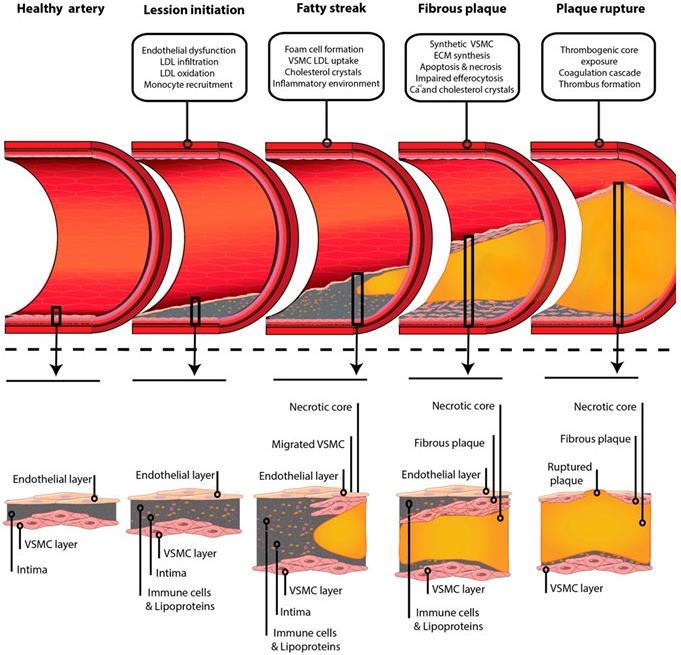Creative Biolabs provides an extraordinary service to isolate targeting peptides for atherosclerotic lesions through our in vivo phage display platform. This platform is able to in vivo interrogate the cell surface, especially to target endothelial cells. Therefore, for the treatment and prevention of atherosclerotic lesions, in vivo phage display technology can play a potential role for novel imaging agent or diagnostic tool discovery.
Atherosclerosis, a leading cause of acute coronary syndromes and stroke, is a major contributor to morbidity and mortality in developed nations, accounting for nearly 500,000 deaths annually in the United States alone. Due to its chronic, slowly progressive nature, this inflammatory disease may remain asymptomatic, often termed clinically silent, for decades before complications arise, by which time the optimal treatment window is usually missed. Early inflammatory lesions are marked by a series of cellular and molecular changes that lead to the formation of mature plaques, with the potential for rupture and thrombosis. Research suggests that the earliest molecular changes in atherosclerosis occur on the endothelial surfaces of the aorta and vasa vasorum, playing a crucial role in the initiation, progression, and thrombotic complications of the disease. Consequently, there is significant interest in discovering novel methods for detecting early-stage atherosclerotic lesions or noninvasively assessing therapeutic efficacy. Creative Biolabs' in vivo phage display platform, with its ability to target endothelial cell peptides, presents a promising approach to achieving this important goal.
Creative Biolabs has developed a novel in vivo phage display platform for selecting tissue-specific peptides. Through this platform, our scientists can broadly interrogate the surface of various cells and specific isolate peptides or protein ligands from atherosclerotic plaque segment. The selection results may display homology to known proteins which may be developed for diagnosis, or uncharacterized proteins which represent potential novel biomarkers of atherosclerosis. Ideally, from these selected peptides and ligands, our clients are able to discover appropriate candidate for the identification of early atherosclerotic lesions or the assessment of curative effect.
With years of research and development experience in phage display realm, scientists of Creative Biolabs are pleased to assist the research and exploration of our clients all over the world. It is our commitment and guarantee to offer high efficiency and quality services for customers with the most competitive price.
 Fig.1 Schematic representation of atheroma plaque formation from a healthy artery to plaque rupture underlying the most important events that contribute to its development in each stage.1
Fig.1 Schematic representation of atheroma plaque formation from a healthy artery to plaque rupture underlying the most important events that contribute to its development in each stage.1
Other optional in vivo phage display screening services:
Atherosclerosis-targeting in vivo phage display library screening is a technique used to identify peptides, proteins, or antibodies that bind specifically to atherosclerotic plaques within blood vessels. This method uses bacteriophages to display vast libraries of peptides or proteins and identifies those that can localize to areas of plaque buildup in live animal models.
Applications include the development of targeted therapies that can reduce plaque buildup, enhance plaque stability, or improve the delivery of imaging agents for diagnostic purposes. Additionally, this technique can help in discovering biomarkers for early detection of atherosclerosis and for monitoring the efficacy of existing treatments.
The types of molecules identified often include peptides that bind to specific proteins or lipids found in atherosclerotic plaques, such as oxidized LDL, fibrin, or collagen. These molecules can be used to develop targeted drug delivery systems or as therapeutic agents to modulate immune responses and reduce inflammation within plaques.
Atherosclerosis-targeting requires specific considerations of the cardiovascular system, such as the dynamic blood flow and the unique composition of atherosclerotic plaques. The technique must ensure that identified peptides can withstand shear forces and bind selectively to plaque components without affecting normal vascular tissues.
Challenges include ensuring the stability and functionality of peptides in the bloodstream, avoiding off-target effects that could lead to increased risk of bleeding or unintended immune responses, and distinguishing between different stages of plaque development. Additionally, the heterogeneous nature of plaques can complicate the identification of universally effective targets.
Commonly used animal models include mice genetically modified to develop atherosclerosis, such as ApoE-deficient or LDL receptor-deficient mice. These models help in studying the progression of atherosclerosis and the efficacy of targeted peptides in a controlled environment that mimics human disease conditions.
Use the resources in our library to help you understand your options and make critical decisions for your study.
All listed services and products are For Research Use Only. Do Not use in any diagnostic or therapeutic applications.